‘Planet Earth II’ Preview: Giraffe vs. Lioness in the Desert
Get ready for your heart to pound again.
As you see in the exclusive sneak peek above from tonight’s “Deserts” episode of BBC America’s Planet Earth II, hungry lions forced to hunt giraffes, whose size and kick strength make them a dangerous meal, do not have it easy on the dunes of Namibia.
Ed Charles, the director and producer of the hour, says he was lucky to work with a husband-and-wife camera team, Will and Lianne Steenkamp, who’d spent an incredible amount of time with this desert pride and had forged a relationship with the scientists who study them. “They basically just lived out of their car for the best part of two years. I mean literally out of their car — they would sleep on the roof in the evening, and during the day they would just be driving around and filming out the side,” Carpenter says. “Because they spent so long with these lions, the access they had was just incredible. We were able to capitalize on that by using what they’d shot and going in and asking them to get additional footage for us.”
He feels particularly privileged to have that footage in the episode because he’s heard recently from the Steenkamps that the pride isn’t doing well. “Many of them have dispersed, some have even been killed. This pride, big for desert lion, was led by the nature of this female, who had learned to hunt giraffes in this way. She’s no longer with us, I’m afraid, so it was a real snapshot in time,” he says. “Despite the fact that she’s trying to jump 11 feet off the ground onto a charging giraffe, she was still very old at that point. They did tell me that they caught up with her some time later, but she was in a really bad way and she was limping around. I think she’d taken a knock from another predation attempt. I think her age just caught up with her.”
Here, Charles takes us inside five more of the episode’s sequences.
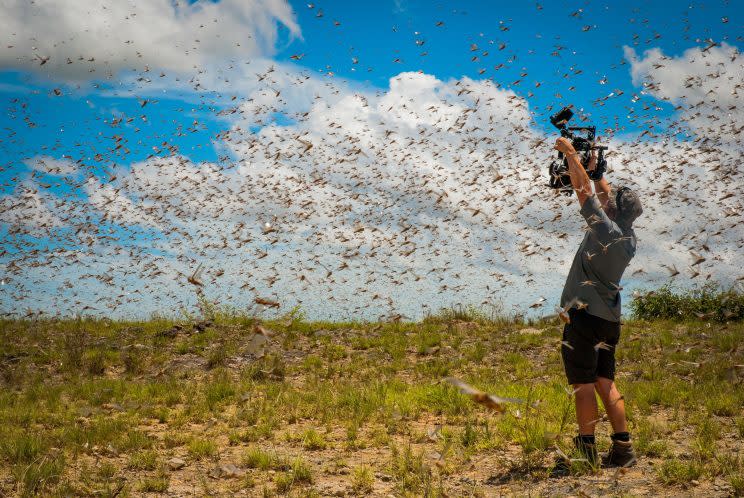
Locust Swarm
The story of the crew’s oft-foiled efforts to find a super swarm of a billion locusts plaguing Madagascar is a highlight of the “making of” episode airing March 25, and not just because we see researcher Toby Nowlan using his “Monday morning locust-herding jazz hands” to try to encourage juvenile hoppers that can’t yet fly to cross the road in front of the cameras. “I think that those jazz hands are going to make him famous,” Charles says.
But they needed to film a swarm in flight, which ultimately became the toughest sequence to shoot — and Charles’ favorite.
“We’d heard Madagascar was experiencing these crazy widespread locust plagues, on a scale not seen for more than a decade. So we knew that we wanted to go out and film it. We worked very closely with the United Nations’ Food and Agriculture Organization, the UNFAO for short, who where out there trying to eradicate the plagues, because, of course, Madagascar is one of the poorest nations on the planet, and these plagues were absolutely ravaging the entire country,” Charles says. Although they expected to film the swarm in the very, very arid area of the country, the locusts had already flown on. And this is where we just need to let him tell it.
“So then ensued this massive road trip. We had to completely change all of our plans. We must have driven thousands of miles, and the locusts were always one step ahead. What was slightly frustrating, as you see in the ‘making of,’ is that this was supposed to be for the ‘Deserts’ episode, but as we were following the locusts, they were heading further north, where they’d actually had an unprecedented amount of rain.
All the roads were flooded, the savanna was a lot lusher than you’d normally expect. But we kept on following them into this incredibly remote part of the country, where very few Westerners ever go. But eventually, we got to a point where we ran out of road. So having forged all these swollen rivers and driving across these roads where the water was coming up over the bonnet, we got, as the ‘making of’ says, defeated by a puddle in the end. The road just turned into this absolute quagmire we couldn’t get across.
We knew that they were just on the savanna further north, so we threw everything we had at trying to get access to one of only two helicopters in the entire country. We were very lucky; I think the helicopter we used had just finished flying the president around, so it was free. We managed to secure it for three days, and that was the way to do it. Because as soon as you’re up in the air, you can see the swarms from a very long way away, and you can see which direction they’re traveling in. You can then fly ’round in front of them, turn off the engines, get out, set the cameras up, and then just wait for them to pass overhead.
It was the most rewarding experience… I wasn’t freaked out by going out to film locusts, but lots of my friends and family were like, ‘Oh, I couldn’t imagine anything worse.’ But once you’re actually in a swarm, it was almost serene. The swarm is miles across, and you just stood in the middle of it. Because there’s so many billions of wings all beating in unison, you kind of lose the air around you and there’s this amazing sound, which is so difficult to describe. It’s like the whirl of a distant waterfall, but up-close. All the locusts fly at you but they part, like a stream going around a rock. It was an incredible experience.”
For series executive producer Mike Gunton, it’s also one of the key ingredients you need in each episode of Planet Earth: spectacle. “I think it’s a very powerful experience to just see sheer spectacular numbers of creatures. When you see locusts swarm with a billion locusts, it is just mindblowing. It’s an overused phrase, but it is,” he says. “For the first time, using these gyroscopic cameras, you’re really able to be in those swarms, to be able to run along and feel like you’re flying and feel the sense of being enveloped in a flying swarm of locusts, which, a lot of people find that quite creepy. One of the things I’ve learned over the years is people have a very strange reaction to insects. Personally, I find bugs absolutely extraordinarily fascinating. But some people absolutely just say, ‘Nope. I’m not watching it. It’s about a bug.'”
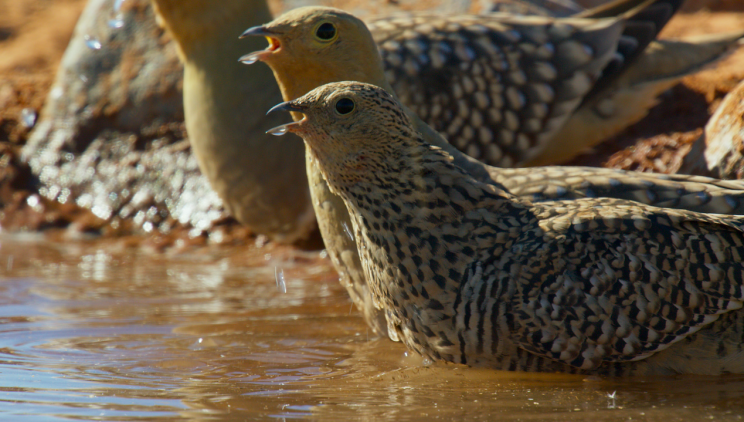
The Daily Sandgrouse Water Run
It’s another incredible story of what parents go through in the wild. Male sandgrouse in Namibia may fly up to 60 miles to reach the waterhole nearest the safety of their remote nesting site, where the females stay behind to shield the chicks from the sun. Once they drink their full, they soak up water in specially adapted breast feathers to take back to their families. They’ll do this every day for two months until the chicks can fly.
“Every morning they come in like clockwork at the same time, and the noise that they make as they fly — it’s this beautiful calling,” Charles says. But the soaking takes time, which makes the sandgrouse prey for hawks, which are the reason the chicks are kept at such a great distance.
“Normally it’s very, very difficult to find the chicks, but I remember I was driving out with someone, and we spooked these sandgrouse from the side of the dirt track and they flew up. I thought, ‘Well that’s a bit weird, what are they doing out here in the middle of the desert?’ I looked down, and sure enough, there just right by the side of the road were these tiny little chicks ready to cross. Just beautiful, beautiful things. It’s amazing where they nested, it’s literally right in the middle of the desert. There’s nothing there, miles from water. But their camouflage is so incredible that they just hunker down,” he says. “Had we not been driving past and spooked their parents, there is no way on earth I would have seen them. I literally could have stepped within two inches of them, and I wouldn’t have seen them. It’s amazing.”
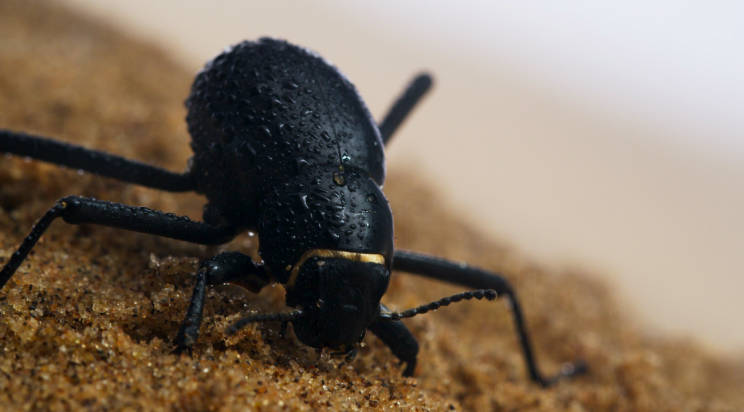
The Darkling Beetle’s Epic Climb
On foggy mornings in Namibia’s Namib Desert, darkling beetles climb to the top of the dunes to collect water from the mist that blows in from the sea. Grooves in the beetles’ casing help channel the water that collects on their bodies toward their mouths. To make it even more interesting, that journey to the top of those dunes is the equivalent of a human climbing Mount Everest — twice.
“You hear about the beetles, and it is an amazing story, but actually filming it is incredibly challenging for a couple of reasons,” Charles says. “The first is that the beetles will only do it when the fog is absolutely the right kind of fog. Now, we never quite figured out what the right kind of fog was, but the beetles have to do it when it’s been dry for a number of days, and then the fog rolls in. If it’s too high they won’t do it, if it’s too damp they won’t do it. We just had to wait. Every morning, you’d go outside before sunrise, and you’d look. On the days when it was right, we would quickly rush out to the dunes. Sure enough, the beetles would start popping out. But the other problem in filming it was that in sand, you leaves tracks. You generally only had one run up the dune face before you then had to move on and find the next slip face and hope the beetles are coming up there, as well. That’s why we got these handheld shots where we’re literally following the beetle up the dune face the entire way, because we really did only have one attempt before we put our own footprints in the sand.”
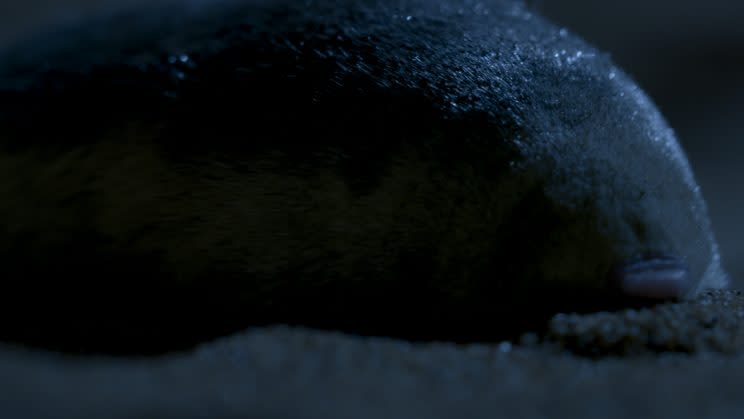
The Golden Mole Sighting
Tracks did help the film crew at times, however. Golden moles in Namibia are rarely seen because they are nocturnal and, well, moles. “They spend much of their time moving around under the sand, and then they pop up, and they’ll scurry around on the top for a bit, then they’ll duck down again,” Charles says. “At first, we started working with one who was a little bit shy, so we thought we’re not going to push this, because you don’t want to cause stress to the animals. But then we found another one, and that is the joy about these animals: they’re really easy to find. They’ve got a very distinct track. You follow it to where it stops, and you know that underneath that sand, there’s going to be a golden mole. We found one that was very amenable, very relaxed. It would come out before sunset and it would scurry around. I’ve actually got a shot on my iPhone of me just walking through the desert with this tiny little golden mole scurrying around between my toes. It was a very charming little thing.”
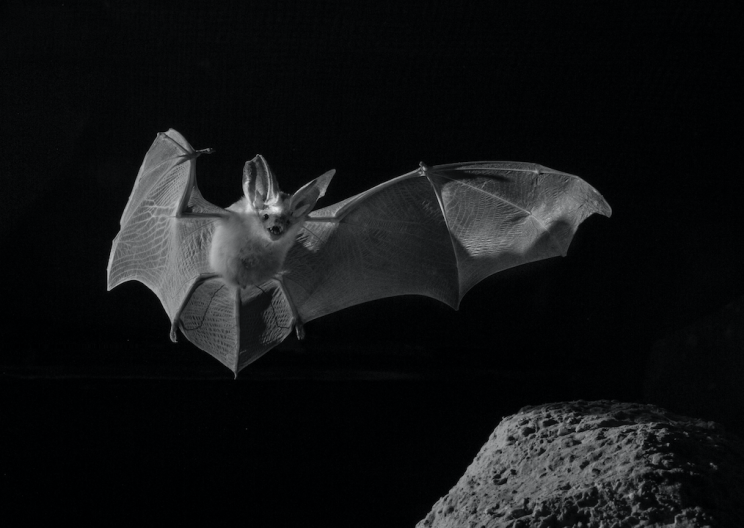
The Desert Long-Eared Bat vs. Deathstalker Scorpions
Each episode of Planet Earth II also needs a first. (“That’s the thing about wildlife filming,” Charles says. “These new stories are kind of the holy grail.”) The crew had heard about a team of scientists who were studying the Otonycteris desert long-eared bat in Israel and had only recently discovered that it hunts deathstalker scorpions, whose venom is strong enough to kill a human. “They just assumed this bat was like any other bat with long ears, it would hunt in the air. But Israel is filled with scorpions,” he says. “The way to discover scorpions in the desert is to take a UV light out with you, a torch. If you shine that on the floor, the scorpions literally glow in the dark, they’re these neon beacons that light up. The scientists were shining this light around so that they didn’t step on a scorpion around one of the bat roosts. Underneath the opening to the bat roost, there were all these droppings, and as they shined the lights onto it, suddenly it all just glowed. They thought, ‘Well, that’s a bit odd.’ So they looked into it, and they thought, ‘Okay, clearly the bats are eating the scorpions.’ But they didn’t know how they were doing it.”
So the Planet Earth II crew collaborated with them, putting their cameras at the same location. “What’s lovely is that we rely heavily on scientists for our research, but we were able to give something back as well, because we took these super slow-motion cameras down, and we were able to show them the footage slowed down by 20 times,” Charles says. “That would reveal aspects of the behavior that they didn’t realize. So it was a lovely partnership, and we were again very lucky to have these incredible scientists doing this incredible work that we were able to piggyback on.”
Planet Earth II‘s “Deserts” episode airs March 11 at 9 p.m. on BBC America.
Read more from Yahoo TV’s Planet Earth II coverage:
‘Planet Earth II’:Inside 7 ‘Jungles’ Moments
‘Planet Earth II’ Producers Preview Must-Watch ‘Mountains’ Moments
‘Planet Earth II’ Executive Producer Mike Gunton Previews Top ‘Islands’ Moments

